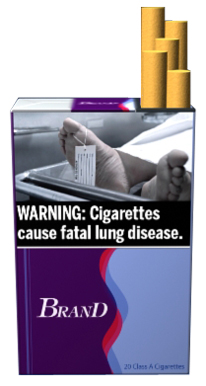FDA announces new graphic cigarette labels

A total of 36 warning labels have been proposed
In recent years, federal and state governments have attempted to crack down on public smoking. The FDA recently approved the addition of new graphic labels on packs of cigarettes in order to make smokers more aware of the health risks associated with tobacco use.
In the past, laws have made smoking sections gradually disappear from bars and restaurants in Texas, and taxes for cigarettes have been imposed. In addition, organizations like Truth and Above the Influence have alerted the public to the risks of addiction and cancer.
However, today 45 million Americans smoke cigarettes, making tobacco products continues to be a multi-million dollar industry.
Efforts to control
Within the past year, the government has been exacting more control over the marketing of tobacco.
Last year, President Barack Obama signed the Tobacco Control Act, which gave the FDA more power to regulate tobacco, especially where the youth of America and public health are concerned. Over the next three years, the act will slowly enforce stricter rules for tobacco companies to follow.
In addition, the FDA’s most recent proposal, part of the Tobacco Control Act, has been a magnet for controversy.
According to the FDA website, the act requires that new, graphic labels be added to cigarette cartons and advertisements beginning in June 2011.
The proposed labels include warnings like “Smoking can kill you” and “Cigarettes cause cancer,” alongside images such as identification tags from morgues and diseased lungs. These new pictures will be required to take up a fifth of cigarette ads and half of cartons’ packaging.
“Some very explicit, almost gruesome pictures may be necessary,” FDA Commissioner Margaret Hamburg said in an interview with Associated Press. “This is a very, very serious public health issue, with very, very serious medical consequences.”
Students React
There are some smokers on the St. Edward’s University campus, however, said they were mostly unmoved by the FDA’s announcement.
“I don’t really care,” freshman Michael Rote said. “It might deter any new smokers, but not any old ones.”
Senior Jaclyn Touchstone agreed.
“I don’t think it’s going to stop anyone from wanting to smoke,” she said.
Even some St. Edward’s staff wonder if the new labels would affect sales. St. Edwards’ Associate Professor of Marketing Daniel Rajaratnam said that he doesn’t think so.
“I really think it’s going to be ignored by smokers. The diehard smokers will have rationalized the consequences, but it could be a deterrent for new smokers,” Rajaratnam said.
It’s All Been Done
The new labels aren’t an original idea and probably won’t work, sophomore Emily Rayburn said.
“I went to London and they had done the same thing; it didn’t affect anyone. It might make more queasy people quit,” she said.
The governments of Canada, Brazil, Australia and Singapore have also been among the countries that have tried these policies. Canada’s smoking rate has decreased five percent in the last decade.
According to the FDA website, final regulations about the labels will be issued by June 22, 2011, and the new warning labels will be required within 15 months following that date.






